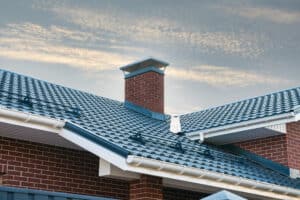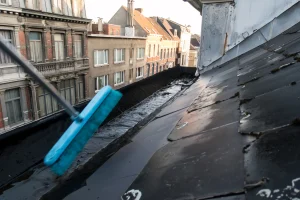Roof scuppers are something most people don’t pay much attention to, but they’re actually a key element in a building’s drainage system. They’re tucked away near the roof edges and their job is to help water flow off the roof and away from the building.
So, what are roof scuppers and why should you care about them? We’re going to chat about what these little devices do, their pros and cons, what other options are out there, and how to keep them working their best.
So, let’s get started on shedding some light on these often unnoticed but important parts of a roofing system.
Key Takeaways
- Roof scuppers are often overlooked but play a crucial role in a building’s drainage system, especially on flat commercial roofs. They prevent water pooling, aid in efficient water management, and protect the roof from damage caused by stagnant water.
- Roof scuppers are drainage devices located near the roof edges. They guide water off the roof, preventing water damage and extending the roof’s lifespan. There are two common types: channel scuppers and through-wall scuppers.
- Roof scuppers are cost-effective and less prone to clogging when sized correctly. They work well with downspouts to direct water away from the building. However, smaller scuppers can get blocked, and some don’t include downspouts, potentially causing foundation and basement issues. Regular maintenance is essential.
- Alternatives to roof scuppers include gutters and drainpipes. Gutters are installed along roof edges to catch and guide rainwater to downspouts, while drainpipes collect and channel water down from the roof. The choice depends on roof type, weather conditions, and building design.
Definition and Function of Roof Scuppers
So, let’s chat about roof scuppers. These are vital drainage tools found on flat commercial roofs. Their job? To stop water from pooling up and to make sure water management is top-notch. They bring a bunch of benefits to the table. For instance, they’re pros at getting rid of water from the rooftop and stopping the damage that can occur from water hanging around too long. By guiding water off the side of the building or down a downspout, roof scuppers help keep the roof strong and sturdy, warding off leaks and making the roof last longer.
Now, there are a couple of popular ways to set up roof scuppers. One way is the channel type. Here, scuppers are put in at regular intervals along the edge of the roof. These scuppers are linked to a channel that whisks the water away from the building. Another way is the through-wall type. Here, scuppers are put through the parapet wall. This way allows water to be drained directly to the ground or down a downspout.
Getting roof scuppers installed properly is super important to make sure they work their best. The scuppers need to be placed just right to let water flow efficiently and stop blockages. Regular check-ups, including cleaning and looking for damage, are also needed to keep the scuppers working their best.
Advantages and Disadvantages of Roof Scuppers
Roof scuppers are a drainage option for your flat roof that you might want to consider. They come with their own set of pluses and minuses, so let’s go through them, shall we?
First off, the good stuff. Roof scuppers are easy on the wallet. If you’re on a budget, they’re a solid choice. Plus, if you get the size right, they’re less likely to get clogged up. This means less maintenance for you and less chance of leaks which could lead to water damage inside your property.
Another plus is that scuppers and downspouts work pretty well together. They help prevent water from pooling around the foundation of your building and make it easy to direct water to where it needs to go.
That said, it’s not all sunshine and rainbows with roof scuppers. The smaller ones, along with downspouts, can get blocked up which can cause drainage problems and water pooling on your roof. Also, some scuppers don’t come with a downspout, so the water ends up running straight down the side of your building. This can lead to problems with your foundation and even flooding in your basement.
And, over time, scuppers can develop issues like mold, mildew, and leaks, so you’ll need to keep an eye on them and take care of any problems that come up.
Alternative Drainage Devices for Roofs
If you’re looking for alternatives to roof scuppers for managing roof drainage, you might want to consider some of these specialized devices. These can work alongside, or even replace, scuppers, depending on your needs. Here’s a couple of popular choices:
- Gutters: These are pretty common for rooftop drainage. You’ll usually spot them installed along a roof’s edges, where they catch rainwater and guide it down towards downspouts. This process helps keep water away from the building. And the great thing about gutters is they come in a variety of shapes, sizes, and materials, so you can tailor them to your roof type and aesthetic taste.
- Drainpipes: Also known as roof drains or downspouts, these vertical pipes are hooked up to the roof’s drainage system. They collect water from the roof and channel it down to the ground or a specific drainage area. Depending on the structure and design of your building, you can install drainpipes either internally or externally.
Both gutters and drainpipes are effective solutions for managing roof drainage, helping you handle rainwater and avoid potential damage from water buildup. When choosing these types of devices, it’s key to consider things like your roof type, your local weather conditions, and the specific needs of your building, to ensure you get the best functionality.
Maintenance Tips for Roof Scuppers
Keeping your roof scuppers in top shape is as important as keeping the roof over your head. After all, if your scuppers aren’t working as they should, you could end up with a water-logged roof. So, let’s talk about how you can keep them functioning at their best.
One common problem with roof scuppers is the build-up of debris like leaves and twigs. This can stop water from flowing through and lead to water pooling on your roof. So, how do you prevent this? The answer is simple – keep your scuppers clean. You can use a small brush or a hose with a high-pressure nozzle to clear out any blockages. After cleaning, make sure that water can flow freely through the scupper.
But cleaning is not the only thing you should be doing. It’s also important to keep an eye out for any signs of damage like cracks, holes, or corrosion. If you spot any such issues, get them fixed or replace the scupper right away. This way, you maintain the scupper system’s integrity.
Now, let’s talk about the area around the scuppers. You want to keep this clear of any obstructions that could interfere with the water flow. This could mean trimming overhanging branches or vegetation that could block the scupper.
One way to make sure all this gets done is to include scupper maintenance in your roofing contractor’s maintenance plan. Regular inspections and cleanings can go a long way in ensuring the functionality and longevity of your roof scuppers.
Frequently Asked Questions
What Is the Difference Between a Scupper and a Drain?
The key differences between a scupper and a drain come down to where they’re installed and what their job is within a roof’s drainage system. Drains are typically positioned smack dab in the middle of the roof. They’re hooked up to pipes and their primary job is to whisk water away. Scuppers, on the other hand, are situated near the edges. They guide water off the roof either via a metal edge, a parapet wall, or they send it down a downspout. When you add scuppers into the mix in a drainage system, you get some really cool benefits, like stopping water from building up and reducing the chance of any damage to the building.
What Is the Difference Between a Gutter and a Scupper?
If you’re looking for some basic knowledge about water drainage systems, you’ve come to the right place. You might be wondering – what’s the difference between a gutter and a scupper? Well, it’s all about their design and purpose. You’ll typically find gutters fixed to the edge of the roof, helping to direct water away from the building. On the other hand, scuppers are these nifty drainage devices that are part of the building design itself. They’re often used in flat-roofed commercial buildings to get rid of standing water. Kinda cool, right?
What Is Scupper in Roofing Terms?
In the world of roofing, you might come across the term ‘scupper.’ But what does it mean, you ask? Well, it’s all about managing water on flat or slightly sloped roofs. Essentially, scuppers are drainage systems that are built into these roofs. They’re typically crafted from sturdy stuff like copper or galvanized steel. The primary goal here is to stop water from collecting and causing any harm, as nobody wants a soggy roof, right? So, if you’re dealing with a flat roof, scuppers are your best bet to keep everything nice and dry.
What Does Scupper Do?
Scuppers are like superheroes for your roof – they help keep it in good condition by stopping water from gathering and causing harm. They’re great at directing water and can even work well with downspouts. But like any superhero, they have their weaknesses. They can get blocked up with debris and sometimes get damaged, which means they need some TLC every now and then to keep them working at their best.






